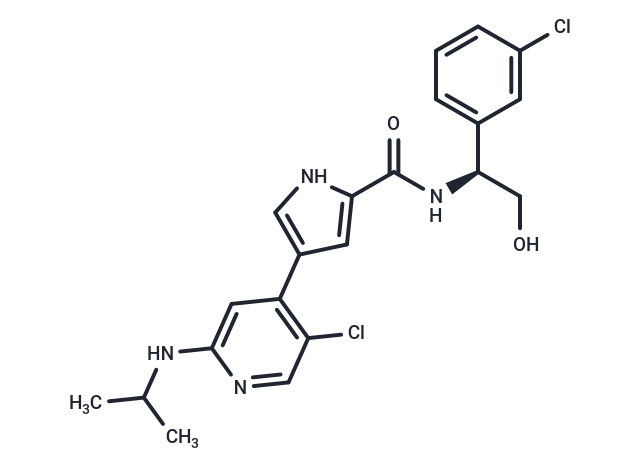Shopping Cart
- Remove All
 Your shopping cart is currently empty
Your shopping cart is currently empty

Ulixertinib (VRT752271) (BVD-523, VRT752271) is an effective and reversible ERK1/ERK2 inhibitor. The IC50 of Ulixertinib is less than 0.3 nM for ERK2.

| Pack Size | Price | Availability | Quantity |
|---|---|---|---|
| 2 mg | $34 | In Stock | |
| 5 mg | $55 | In Stock | |
| 10 mg | $89 | In Stock | |
| 25 mg | $143 | In Stock | |
| 50 mg | $197 | In Stock | |
| 100 mg | $372 | In Stock | |
| 200 mg | $538 | In Stock | |
| 500 mg | $857 | In Stock | |
| 1 mL x 10 mM (in DMSO) | $61 | In Stock |
| Description | Ulixertinib (VRT752271) (BVD-523, VRT752271) is an effective and reversible ERK1/ERK2 inhibitor. The IC50 of Ulixertinib is less than 0.3 nM for ERK2. |
| Targets&IC50 | ERK2:<0.3 nM |
| In vitro | In an A375 melanoma cell line containing a b-RAFV600E mutation, Ulixertinib reduces the levels of phosphorylated ERK2 (pERK) and of the phosphorylation of the downstream kinase RSK (pRSK) with IC50 of 4.1/0.14 μM, respectively. Ulixertinib also inhibits A375 cell proliferation with IC50 of 180 nM. [1] |
| Kinase Assay | ERK2 Rapidfire Mass Spectrometry Inhibition of Catalysis Assay: MEK U911-activated ERK2 protein is expressed and purified in-house. Enzyme and substrate solutions are made up in assay buffer consisting of 50 mM Tris (pH 7.5), 10 mM MgCl2, 0.1 mM EGTA, 10 mM DTT and 0.01% (v/v) CHAPS. 1.2 nM ERK2 protein is prepared in assay buffer and 10 μL is dispensed into each well of a polypropylene, 384-well plate containing test and reference control compounds. The compound plates had previously been dosed with a 12 point range from 100 μM down to 0.1 nM in order to calculate compound IC50s, with a total DMSO concentration in the assay of 1%. Following a 20 minute pre-incubation of enzyme and compound at room temperature, 10 μL of substrate solution is added consisting of 16 μM Erktide (IPTTPITTTYFFFK) and 120 μM ATP (measured Km) in assay buffer. The reaction is allowed to progress for 20 minutes at room temperature before being quenched by the addition of 80 μl 1% (v/v) formic acid. The assay plates are then run on the RapidFire Mass Spectrometry platform to measure substrate (unphosphorylated Erktide) and product (phosphorylated Erktide) levels. |
| Cell Research | A375 cells are cultured in cell media composed of DMEM, 10% (v/v) Foetal Calf Serum and 1% (v/v) L-Glutamine. After harvesting, cells are dispensed into black, 384-well Costar plates to give 200 cells per well in a total volume of 40 μL cell media, and are incubated overnight at 37°C, 90% relative humidity and 5% CO2 in a rotating incubator. Test compounds and reference controls are dosed directly into the cell plates, into the inner 308 wells, using a Labcyte Echo 555 acoustic dispenser. The cells are dosed over a 12 point range from 30 μM down to 0.03 nM in order to calculate compound IC50s, with a total DMSO concentration in the assay of 0.3%. The cell plates are then incubated for 72 hours at 37°C. Cells were fixed and stained by the addition of 20 μL 12% formaldehyde in PBS/A (4% final concentration) and 1:2000 dilution of Hoechst 33342, with a 30 minute room temperature incubation, and then washed with PBS/A. A cell count is performed on the stained cell plates using a Cellomics ArrayScanTM VTI imaging platform. A Day 0 cell plate is also fixed, stained and read to generate a cell count baseline for determining compound cytotoxic effects as well as anti-proliferative effects.(Only for Reference) |
| Alias | VRT752271, BVD-523 |
| Molecular Weight | 433.33 |
| Formula | C21H22Cl2N4O2 |
| Cas No. | 869886-67-9 |
| Smiles | CC(C)Nc1cc(-c2c[nH]c(c2)C(=O)N[C@H](CO)c2cccc(Cl)c2)c(Cl)cn1 |
| Relative Density. | 1.359 g/cm3 |
| Storage | store at low temperature | Powder: -20°C for 3 years | In solvent: -80°C for 1 year | Shipping with blue ice. | |||||||||||||||||||||||||
| Solubility Information | H2O: < 1 mg/mL (insoluble or slightly soluble) DMSO: 70 mg/mL (161.54 mM), Sonication is recommended. 10% DMSO+40% PEG300+5% Tween 80+45% Saline: 8 mg/mL (18.46 mM), In vivo: Please add the solvents sequentially, clarifying the solution as much as possible before adding the next one. Dissolve by heating and/or sonication if necessary. Working solution is recommended to be prepared and used immediately. Ethanol: 12 mg/mL (27.69 mM), Sonication is recommended. | |||||||||||||||||||||||||
Solution Preparation Table | ||||||||||||||||||||||||||
Ethanol/DMSO
DMSO
| ||||||||||||||||||||||||||

Copyright © 2015-2025 TargetMol Chemicals Inc. All Rights Reserved.